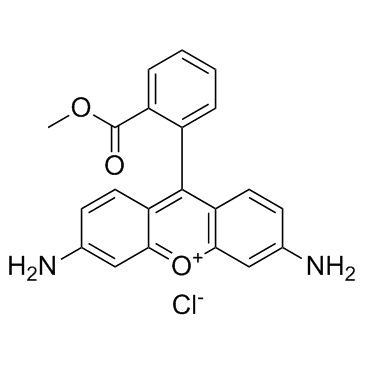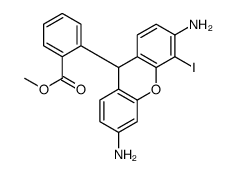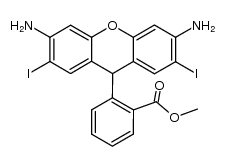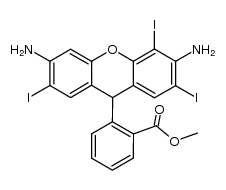Dihydrorhodamine 123

Dihydrorhodamine 123 structure
|
Common Name | Dihydrorhodamine 123 | ||
|---|---|---|---|---|
| CAS Number | 109244-58-8 | Molecular Weight | 346.379 | |
| Density | 1.3±0.1 g/cm3 | Boiling Point | 526.9±50.0 °C at 760 mmHg | |
| Molecular Formula | C21H18N2O3 | Melting Point | N/A | |
| MSDS | Chinese USA | Flash Point | 222.4±26.4 °C | |
Use of Dihydrorhodamine 123Dihydrorhodamine 123 is a fluorescent probe (λex=488 nm, λem=525 nm). |
| Name | Dihydrorhodamine 123 |
|---|---|
| Synonym | More Synonyms |
| Description | Dihydrorhodamine 123 is a fluorescent probe (λex=488 nm, λem=525 nm). |
|---|---|
| Related Catalog | |
| In Vitro | In the presence of 10 μM Dihydrorhodamine 123 (DHR) the stimulation of the neutrophil NADPH oxidase by the addition of 50 nM phorbol 12-myristate 13-acetat (PMA) resultes in an increase in the rate of rhodamine generation. The fluorescent intensity of the cells, in the presence of 10 μM Dihydrorhodamine 123, increases with time following the addition of 50 nM PMA. In the presence of 10 μM Dihydrorhodamine 123, induced HL60 cells show a sustained increase in fluorescence following the addition of 50 nM PMA[1]. |
| Cell Assay | The HL60 cells are incubated at 6×106 cells/mL in Krebs-Ringer buffer at 37°C containing 10 μM Dihydrorhodamine 123 (DHR). The generation of O2- is initiated by the addition of 50 nM phorbol 12-myristate 13-acetat (PMA) and the progress of the generation of rhodamine 123 is monitored in 50-μL aliquots (3×105 cells) diluted tenfold before analysis. The uninduced HL60 cells are loaded with 5 μM carboxy SNARF-1 AM acetate (SNARF-AM) in the Na+ medium for 10 min at 37°C and washed by centrifugation and resuspension to remove unhydrolysed SNARF ester[1]. |
| References |
| Density | 1.3±0.1 g/cm3 |
|---|---|
| Boiling Point | 526.9±50.0 °C at 760 mmHg |
| Molecular Formula | C21H18N2O3 |
| Molecular Weight | 346.379 |
| Flash Point | 222.4±26.4 °C |
| Exact Mass | 346.131744 |
| PSA | 87.57000 |
| LogP | 1.84 |
| Vapour Pressure | 0.0±1.4 mmHg at 25°C |
| Index of Refraction | 1.684 |
| Storage condition | -20°C |
| Personal Protective Equipment | Eyeshields;Gloves;type N95 (US);type P1 (EN143) respirator filter |
|---|---|
| Hazard Codes | T+ |
| Safety Phrases | S22-S24/25 |
| RIDADR | NONH for all modes of transport |
| WGK Germany | 3.0 |
| HS Code | 2932999099 |
|
~% 
Dihydrorhodamine 123 CAS#:109244-58-8 |
| Literature: Journal of Medicinal Chemistry, , vol. 30, # 10 p. 1757 - 1761 |
|
~6% 
Dihydrorhodamine 123 CAS#:109244-58-8 |
| Literature: Kundu, Kousik; Knight, Sarah F.; Lee, Seungjun; Taylor, W. Robert; Murthy, Niren Angewandte Chemie - International Edition, 2010 , vol. 49, # 35 p. 6134 - 6138 |
| HS Code | 2932999099 |
|---|---|
| Summary | 2932999099. other heterocyclic compounds with oxygen hetero-atom(s) only. VAT:17.0%. Tax rebate rate:13.0%. . MFN tariff:6.5%. General tariff:20.0% |
|
A yeast model of the Parkinson's disease-associated protein Parkin.
Exp. Cell Res. 333(1) , 73-9, (2015) Mutations in Parkin, an E3 ubiquitin ligase, are associated to autosomal recessive Parkinson's disease (PD). Parkin has been mainly implicated, along with Pink1, in mitochondrial autophagy in response... |
|
|
Interferon-gamma induced cell death: Regulation and contributions of nitric oxide, cJun N-terminal kinase, reactive oxygen species and peroxynitrite.
Biochim. Biophys. Acta 1843(11) , 2645-61, (2014) Interferon-gamma (Ifnγ), a known immunomodulatory cytokine, regulates cell proliferation and survival. In this study, the mechanisms leading to the selective susceptibility of some tumor cells to Ifnγ... |
|
|
Antimicrobial mechanism of resveratrol-trans-dihydrodimer produced from peroxidase-catalyzed oxidation of resveratrol.
Biotechnol. Bioeng. 112 , 2417-28, (2015) Plant polyphenols are known to have varying antimicrobial potencies, including direct antibacterial activity, synergism with antibiotics and suppression of bacterial virulence. We performed the in vit... |
| MFCD00285712 |
| Benzoic acid, 2-(3,6-diamino-9H-xanthen-9-yl)-, methyl ester |
| Methyl 2-(3,6-diamino-9H-xanthen-9-yl)benzoate |


 CAS#:109282-63-5
CAS#:109282-63-5 CAS#:109244-59-9
CAS#:109244-59-9 CAS#:109244-61-3
CAS#:109244-61-3 CAS#:109244-60-2
CAS#:109244-60-2 CAS#:109244-62-4
CAS#:109244-62-4
